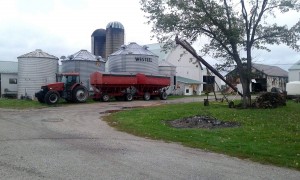The livelihood of raising livestock
By Kylie Turner
A local farm will not have cattle anymore because of the labour involved, but most of Ontario’s dairy and swine farmers are getting out of the business.
Jennifer Howson, 21, with Howson Family Farms, said they will no longer have cattle at the farm because they are a lot of work and her dad and grandparents are getting older.
Howson Family Farms celebrated their 90th anniversary this year but Howson said the farm was not primarily a dairy farm during all of those years. She said the cattle were used to provide milk for multiple companies which made cheese and pasteurized milk.
“We will continue farming field crop like wheat, soybeans and corn,” said Howson. “The hardest part about working with cattle is the daily milking because we have a Tie-Stall barn. That means there is a lot of bending involved and we have wake up early, around 5 a.m., to milk the cows.”
According to Statistics Canada, dairy cow populations in Ontario have decreased by 3.5 per cent and the number of swine has decreased by almost 22 per cent since 2006. In 2011 the herds started to decrease, Ontario continues to have the second-largest dairy herd with more than 318, 000 cows and the second-highest number of pigs in the country with 3.1 million, both statistics being second to Quebec.
Ken McEwan is a college professor of production economics and agribusiness. One of his specialties of study include evaluating the structural changes within the Ontario swine industry. McEwan is a professor at the University of Guelph Ridgetown campus which is an Ontario Agriculture College.
He said one of the main challenges the swine industry faces is continuous capital. Prices fluctuate and it is expensive to purchase land and buildings and there are dramatic price changes with the pork sector due to a delicate balance of supply and demand.
“The swine sector is very competitive and there is risk because of swings in profitability and capital involved,” said McEwan. “The dependant relies on the global market place with a risk cycle. There are usually two years of profit, but lately that has changed and no one knows what it is now.”
Howson said there are new legislation’s coming into place within the next few years and they would have to build a new barn which is costly.



